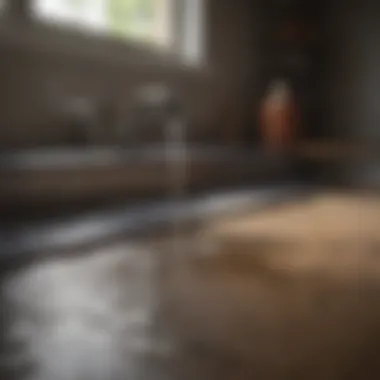Home Remedies for Effective Drain Maintenance


Intro
Home Features
A well-maintained home often reflects on its functional systems, including drains. Addressing these systems helps protect the overall integrity of one’s living space. When it comes to maintaining drains, certain home features play a pivotal role.
Common Household Structures
Most homes share similar plumbing setups. Kitchen sinks, bathroom drains, and laundry lines are typically connected to a single drainage system. Because of this, a blockage in one area can affect others. Recognizing this interconnectedness is crucial when considering home remedies.
Interior Design Considerations
The modern trend towards open-concept living spaces can often lead to more collected debris in drains. With such layouts, kitchens and living areas are less separated, which can create an environment where food particles and hair are more likely to gather in the plumbing. Home remedies that target this buildup are essential for maintaining cleanliness and integrity of the interior design aspects of a home.
Practical Remedies
The insight into using effective methods to maintain proper drainage is empowering for homeowners. Here are several practical home remedies that utilize common household materials to keep drains clear:
- Baking Soda and Vinegar: The classic duo is excellent for breaking down organic matter. Pour half a cup of baking soda followed by half a cup of vinegar down the drain. Allow it to bubble for about 30 minutes, then flush it with hot water.
- Salt and Hot Water: This simple remedy can help dislodge minor blockages. Pour a generous amount of salt down the drain, followed by boiling water. This combination helps break down debris.
- Baking Soda Paste: For stubborn clogs, mix baking soda with water to create a paste. Apply it directly to the affected drain and let it sit for at least an hour before rinsing with hot water.
- Dish Soap and Hot Water: If grease is the issue, pour dish soap down the drain, followed by hot water. This can help dissolve and flush away greasy buildup.
"Using readily available materials not only saves money but also promotes a safer home environment by eliminating the need for harsh chemicals."
These remedies highlight the value of utilizing home resources to tackle plumbing challenges. With consistent application, homeowners can maintain clear drains without significant effort or expense.
Understanding Drain Issues
Understanding the issues that affect drains is fundamental for homeowners. This knowledge equips them to maintain their plumbing systems effectively and avoid costly problems. Drainage systems play a critical role in any home, as they are responsible for the efficient disposal of wastewater. Neglecting drain issues can lead to severe complications, including foul odors and water damage. Having a grasp of common drain problems and their signs facilitates proactive maintenance.
Common Drain Problems
Drain systems can face various challenges. Some of the most prevalent issues include:
- Clogs: One of the most frequent problems is blockages in the drain. These can occur due to a buildup of debris, grease, hair, and food particles. Over time, even small amounts of waste can accumulate, causing significant blockages.
- Slow Draining: If water takes longer to drain than usual, it is a strong indicator of an underlying issue. Slow draining can signal partial clogs that might worsen if not addressed promptly.
- Foul Odors: Unpleasant smells emanating from drains often suggest trapped waste or stagnant water. This condition might require immediate action to avoid more severe plumbing problems.
- Backups: If wastewater begins to flow back into the sink or tub, this is a serious warning sign. Backups can create unsanitary conditions and require professional expertise to resolve.
Signs of Clogged Drains
Recognizing signs of clogged drains is crucial for effective maintenance. Here are some indicators:
- Gurgling Sounds: When drains make strange gurgling noises, this can indicate air trapped in the system, often a precursor of clogs.
- Water Puddles: Any pooling around the drain area suggests that water cannot flow as intended. This can result from blockages or improper drainage installation.
- Multiple Fixture Issues: When more than one drain and fixture in the house exhibit problems, it often points to a more significant issue in the main drainage system.
"Understanding the signs and symptoms of common drain problems can save homeowners significant time and money in the long run."
Being vigilant about these signs will allow homeowners to tackle drain problems before they escalate into costly repairs. Incorporating regular inspections and maintenance into household routines is not just beneficial but essential for long-term drain health.
Why Choose Home Remedies
When it comes to maintaining drains, many homeowners are increasingly turning to home remedies. This shift is not merely a trend; it reflects a deeper understanding of the value of natural solutions. Utilizing home remedies can lead to significant cost savings, improved safety, and overall better management of plumbing systems.
One of the primary reasons to opt for home remedies is their effectiveness. Natural ingredients often prove effective at breaking down clogs and maintaining clear drains. These remedies typically use substances already found in most households, such as baking soda and vinegar. This makes them accessible and convenient for immediate use without the need for extensive shopping or preparation.
Benefits of Natural Solutions
Natural solutions offer several advantages that are hard to overlook. For instance, they tend to be safer for both users and the environment. Traditional chemical drain cleaners often contain harsh substances that can lead to safety issues. They may pose dangers to children, pets, and even the plumbing system itself. In contrast, natural alternatives, such as baking soda and lemon juice, are non-toxic and biodegradable. This means they do not pose similar risks and promote healthier living spaces.
In addition to safety, natural solutions often lead to fewer long-term harms for plumbing systems than their chemical counterparts. Some commercial cleaners can corrode pipes and cause long-term damage. With natural remedies, the risk of such detrimental effects is markedly reduced.


Moreover, the ease of using common household items is appealing. Home remedies often involve simple mixing or pouring of ingredients, making the process straightforward. This practicality empowers homeowners to address drain maintenance issues without waiting for a professional or relying on potentially unsafe chemicals.
Environmentally Friendly Alternatives
Choosing home remedies for drain maintenance is also an environmentally conscious decision. Many commercial drain cleaning products contain pollutants that can harm local waterways and ecosystems when they enter the sewage system. Home remedies, being mostly derived from natural components, limit this environmental impact.
For those concerned about their carbon footprint or ecosystem preservation, utilizing home remedies reflects a lifestyle aligned with sustainability. Options such as vinegar, lemon, and salt not only contribute to drain cleanliness but do so without introducing harmful chemicals.
Additionally, using environmentally friendly alternatives contributes to a culture of responsible consumption. It encourages mindfulness around the products we use daily and their broader implications on health and the environment.
"Home remedies embody a mindful approach to maintenance, encouraging proactive care and environmental responsibility."
In summary, opting for home remedies in drain maintenance offers both practical and ethical benefits. It allows homeowners to handle their plumbing challenges effectively while promoting a safer and more sustainable living environment. By focusing on natural solutions, individuals not only solve their plumbing issues but also contribute to a healthier planet.
Essential Home Ingredients for Drains
Effective drain maintenance often depends on readily available household items. These ingredients are not only common but also environmentally friendly. Utilizing them can lead to significant improvements in drain function without the need for harsh chemicals. Understanding these essential ingredients helps in crafting effective home remedies that can alleviate common drain issues, making drain maintenance a simpler task for homeowners.
Baking Soda and Vinegar
Baking soda and vinegar are two of the most popular home remedies for clearing clogged drains. Baking soda acts as a mild abrasive and a natural deodorizer. When introducing it into a drain, it can help eliminate unwanted smells. On the other hand, vinegar is an acid that can break down mineral deposits and organic matter.
The reaction between baking soda and vinegar creates carbon dioxide bubbles. This fizzing action can help to dislodge debris and loosen accumulated gunk within the pipes. To use this method, simply follow these steps:
- Pour half a cup of baking soda down the drain.
- Follow with half a cup of vinegar.
- Allow the mixture to sit for about 30 minutes.
- Flush the drain with hot water.
This process is both effective and safe for most plumbing systems.
Salt and Boiling Water
The combination of salt and boiling water serves as another effective remedy for drains. Salt is a natural abrasive, and when combined with boiling water, it enhances the cleaning process. This remedy not only assists in breaking down minor clogs but also helps prevent buildup within pipes.
To apply this method, heat water to a boil and pour about one cup of salt down the drain. After the salt, slowly pour the boiling water. Let the mixture work for a few minutes before rinsing with cold water. This method is great for routine maintenance to keep your pipes clear and functioning well.
Lemon Juice and Baking Soda
Lemon juice is an additional home ingredient that can enhance the effectiveness of baking soda. Lemon juice contains citric acid, which can help dissolve soap scum and grease within pipes. When mixing lemon juice with baking soda, the combination not only helps clear clogs but also leaves a fresh scent.
Implement this method by first pouring a cup of baking soda down the drain, followed by a cup of lemon juice. Allow it to fizz for approximately 15-20 minutes. Afterward, rinse thoroughly with hot water. This practice results in a clean drain and can benefit the overall plumbing system.
Step-by-Step Home Remedies
When it comes to maintaining drains effectively, understanding step-by-step home remedies is crucial. Each method employs easily accessible household ingredients, making the solutions practical for everyday use. Home remedies not only provide an opportunity to manage clogs and build-up but they also save money and avoid hazardous chemicals often found in commercial products. Comprehending these methods allows homeowners to take proactive steps in ensuring a clearer plumbing system without relying on external help.
Baking Soda and Vinegar Method
The baking soda and vinegar method is perhaps the most well-known home remedy for drain maintenance. This technique works due to a simple chemical reaction. When baking soda, a base, meets vinegar, an acid, they produce carbon dioxide gas, which can help dislodge debris within the pipes.
- Pour one cup of baking soda down the drain, followed by one cup of vinegar.
- You should quickly cover the drain with a plug or a cloth. This step prevents the reaction from escaping, allowing the fizzing action to penetrate clogs more effectively.
- Let the mixture sit for about 30 minutes, giving it time to work through the blockage.
- Afterward, flush the drain with hot water, which can help wash away any loosened debris.
This method is not just effective but also environmentally friendly, making it a top choice for many homeowners.
Salt and Boiling Water Process
The salt and boiling water process is another reliable remedy. Salt acts as an abrasive that can help remove build-up while boiling water effectively dissolves grease and other obstructions.


- Start by boiling a kettle full of water.
- As the water heats, measure one cup of salt.
- Once the water reaches boiling point, carefully pour half the boiling water down the drain.
- Follow this by pouring in the salt.
- Finally, add the remaining boiling water.
- Allow it to sit for several minutes to let the salt do its work.
This method is especially useful for kitchen sinks where grease is often a problem. The combination can help maintain a clearer and more functional drainage system.
Lemon Juice and Baking Soda Technique
Using lemon juice combined with baking soda is an effective way to maintain fresh-smelling drains while also preventing clogs.
- Begin by squeezing half a lemon to extract the juice, and pour it down the drain.
- Next, add one cup of baking soda.
- The acidity of the lemon juice will react with the baking soda, creating a fizzing action that can dislodge particles.
- Let the mixture sit for about 15-20 minutes, providing time for the combined ingredients to work through the drain.
- Finally, flush with hot water to clear the pipes.
This technique not only aids in clearing clogs but also adds a pleasant citrus scent to your drain.
By utilizing these step-by-step remedies, homeowners can ensure consistent drainage health without chemical-heavy solutions.
Preventative Measures for Drain Maintenance
Preventative measures are essential to maintaining clear and functional drains. Regular attention can greatly reduce the occurrence of clogs, saving time and money in the long run. By addressing potential issues before they develop into significant problems, homeowners can ensure a smoother drainage system. It is much simpler to prevent blockages than to deal with them after they occur. Here, we detail a few effective strategies.
Regular Cleaning Practices
Implementing a routine cleaning regimen is one of the most effective ways to maintain drains. This process does not have to be overly complicated. Basic methods include:
- Monthly vinegar and baking soda flush: Combine one cup of each and let it sit for at least 30 minutes before rinsing with boiling water. This helps to dissolve buildup inside the pipes.
- Weekly hot water flush: Pouring hot water down the drain helps keep grease and soap residues from sticking to the pipes.
Cleaning drains regularly removes debris and buildup, preventing clogs before they form. It can assure that water flows freely and efficiently through the plumbing system.
Using Drain Screens
Drain screens are simple devices that can significantly reduce the amount of detritus that enters the plumbing system. These screens are inexpensive and can easily be installed over sink and bath drains. Here are some benefits of using drain screens:
- Reduces debris: Screens can catch hair, food particles, and other debris that could otherwise create clogs.
- Easy to clean: Most drain screens can simply be removed and cleaned, making maintenance straightforward.
- Cost-effective: Considering their low cost, they provide excellent value by preventing expensive plumbing repairs in the future.
By effectively blocking large particles and debris, drain screens help maintain the health of your drainage system with minimal effort.
Best Practices to Avoid Clogs
Being proactive in avoiding clogs can enhance the longevity of your drains. Here are several best practices:
- Avoid flushing inappropriate items: Items such as wipes, cotton balls, and feminine hygiene products do not break down easily and can lead to blockages.
- Be mindful of grease disposal: Fat, oil, and grease should never be poured down the drain, as they solidify and lead to serious clogs. Instead, collect them in a container and dispose of them in the trash.
- Educate other household members: Everyone in the home should understand what can and cannot go down the drain. By having open dialogues about drain care, issues can be mitigated.
By following these practices, homeowners can keep their drains running smoothly and effectively.
Remember: Prevention is always more effective than remedying a problem later. By investing a little time regularly, a well-maintained drainage system can be achieved.
Alternative Natural Remedies to Consider
Alternative natural remedies offer practical solutions for maintaining clear drains. These methods are often safer for the environment and more accessible than chemical cleaners. Homeowners may consider these remedies as part of their regular maintenance routine to prevent serious drainage problems in the future. Utilizing common household items means avoiding costly plumbing services. Furthermore, these remedies tend to be more gentle on the plumbing system while still providing effective results.
Dish Soap and Hot Water
Dish soap serves as a surprisingly effective remedy for clogged drains. When mixed with hot water, dish soap helps to break down grease and build-up, making it easier for water to flow through the pipes. This method is especially useful in kitchens where oils and fats often cause clogs. The technique is straightforward: First, bring a pot of water to a boil. Once boiling, add a generous amount of dish soap to the pot. Then, pour the mixture directly down the drain. The combination of hot water and soap will help dissolve the sludge and fatty deposits in the pipes.
Some important things to consider include the type of dish soap used. Opt for a brand that is free from harsh chemicals. It's also wise to test this method periodically as part of a regular drain maintenance schedule, rather than waiting for a significant blockage to happen.
Enzyme-Based Cleaners


Enzyme-based cleaners are an alternative that utilizes natural enzymes to break down organic matter in drains. These cleaners are designed to target build-up caused by food particles, soap scum, and hair. They operate slowly but can be very effective with consistent use. The enzymes digest organic materials without harming the plumbing infrastructure.
Using enzyme-based cleaners usually involves pouring them down the drain and allowing them to sit for several hours or overnight. While they may not show immediate results, patience here is key. Homeowners should read product instructions carefully to understand how long to allow the cleaner to work before flushing it with hot water.
Enzyme-based cleaners are highly effective, especially when used regularly as part of a maintenance routine. They provide a sustainable option to traditional chemical solutions.
Utilizing these natural remedies allows homeowners to engage more actively in their home maintenance. Equipping themselves with the knowledge of these techniques empowers them to handle minor drain issues with confidence and keeps the plumbing system functional. This approach aligns well with a philosophy of sustainable living, making it favorable for both homeowners and the environment.
Assessing the Effectiveness of Remedies
Understanding how to evaluate the effectiveness of home remedies is vital for homeowners. Not every method works for every situation. By being discerning, users can determine which solutions provide tangible results and which ones may fall short. The evaluation process involves considering not only the immediate outcomes but also the long-term implications of each method.
Aside from saving time and effort, knowing the effectiveness of remedies enhances safety. Some homeowners may be tempted to try multiple solutions simultaneously, which can sometimes lead to unforeseen consequences. It’s crucial to have a systematic approach for assessing remedies to ensure that any decisions made contribute positively to the household drainage system.
When to Seek Professional Help
Recognizing when a situation exceeds the bounds of home remedies is important. If a homeowner finds that standard methods yield no results after repeated applications, it may be time to consult a professional plumber. Persistent clogs that cannot be dislodged, foul odors, or unusual sounds coming from the pipes may indicate a deeper issue that DIY methods cannot address.
Moreover, signs of water backing up into sinks or tubs often require immediate intervention. Professionals can diagnose problems accurately and provide solutions that can fix issues quickly and thoroughly.
Evaluating Results from Home Remedies
After applying home remedies, it’s essential to assess their effectiveness critically. Some key elements to consider in this evaluation are:
- Timing: Observe how quickly the remedy begins to take effect.
- Visual Inspection: Check for any visible improvement in flow or reduction in clogs.
- Subsequent Performance: Monitor how drains behave in the days following the treatment.
An effective home remedy should show constructive results within a reasonable time frame. Therefore, keeping a record of results may prove useful for identifying patterns. By carefully analyzing how each remedy performs, homeowners can refine their approaches to drain maintenance, ensuring a functional plumbing system with minimal hassle.
Long-Term Drain Health and Maintenance
The longevity and functionality of drainage systems are not just crucial for immediate comfort. They also significantly affect the overall health of a home. Long-term drain health ensures that plumbing remains effective over the years, which can save homeowners significant money and stress. Routine maintenance can avert bigger problems that may necessitate expensive repairs. By maintaining drains regularly, one can prevent build-up, leaks, and the unpleasant odors that often accompany clogged systems.
Creating a Maintenance Schedule
Establishing a maintenance schedule is vital for ensuring the health of your drains. This involves regular checks and preventive actions that help keep your drains clear and functioning efficiently. Consider the following elements when creating a schedule:
- Frequency: Decide how often to check your drains. Monthly inspections might be a good start, with deeper cleanings every three to six months.
- Actions to Take: Include steps such as running hot water down the drain, using natural cleaners, and inspecting for visible debris.
- Tracking: Use a calendar or app to mark when maintenance is performed, helping to establish a rhythm that becomes part of your home care routine.
- Seasonal Considerations: Make adjustments based on seasonal changes. For example, autumn leaves may necessitate more frequent cleanings if they are getting into the system.
Staying Informed on Drain Care
Knowledge is essential for effective drain maintenance. Staying informed means understanding not just how to perform maintenance but also recognizing what habits can lead to clogs. Here are some actions to consider:
- Research: Regularly read up on drain issues and effective remedies. Websites like Wikipedia can provide foundational knowledge, while community discussions on platforms like Reddit can offer real-world experiences and solutions.
- Home Care Classes: Some local communities or home improvement stores offer classes on home maintenance, including drain care. Participating can provide valuable hands-on experience.
- Consult Professionals When Needed: Don’t hesitate to ask for advice when behavior regarding drains becomes confusing. It's better to consult a plumber before problems escalate.
"Preventive maintenance is better than repair; it can save a great deal of time and money."
Through a harmonious blend of routine maintenance and continuous learning, homeowners can ensure that their drainage systems remain in optimal condition. The importance of long-term drain health cannot be understated—it is foundational to maintaining a comfortable and hygienic home environment.
Epilogue
In a world where the maintenance of household systems often leans towards professional help or chemical solutions, understanding the home remedies for drain maintenance holds significant value. This article has shed light on various effective methods that utilize simple, natural ingredients. Embracing these remedies not only safeguards your drains but also encourages a sense of autonomy in managing household issues.
One crucial element emphasized throughout this discussion is the importance of preventative measures. Regular cleaning and utilizing techniques like baking soda combined with vinegar can dramatically reduce the occurrence of clogs. Further, creating a maintenance schedule allows homeowners to stay ahead of potential problems, ensuring long-term functionality of their drainage systems.
Thinking about environmental considerations, the shift towards natural cleansing agents is also imperative. By opting for home remedies, individuals contribute to reducing chemical pollutants that often find their way into water systems.
Home maintenance does not have to be a daunting task. Rather, it can be approached with straightforward strategies that yield effective results. The blend of knowledge shared, from assessing the effectiveness of various methods to understanding the signs of drain issues, equips readers to make informed decisions.
With ongoing care and attention, anyone can maintain their drains in optimal condition. Ultimately, the journey towards effective home management lies in understanding and applying basic solutions that enhance one's living environment.
"Empower yourself with knowledge and practical techniques, transforming household maintenance into a manageable endeavor."
The benefits of leveraging home remedies for drain maintenance extend beyond simple convenience; they embody a commitment to sustainable living and proactive home care.















